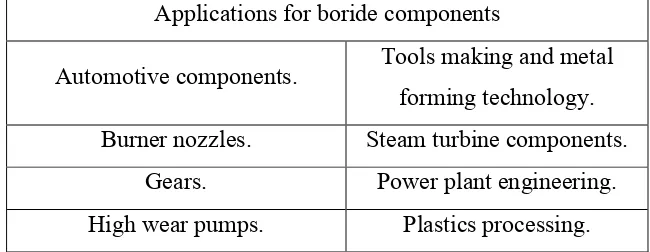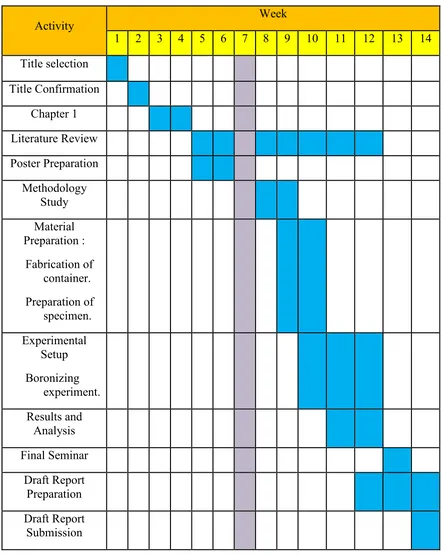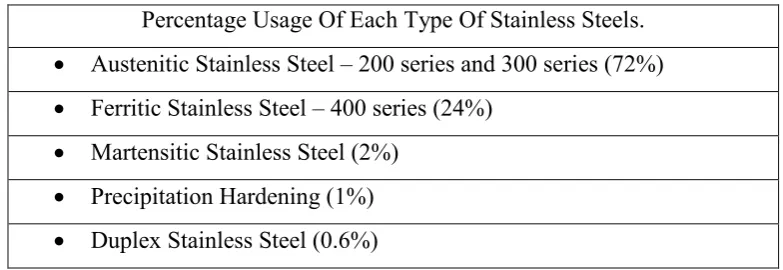i
SUPERVISOR DECLARATION
“I hereby declare that I have read this thesis and in my opinion this thesis is sufficient in terms of scope and quality for the award of the degree of
Bachelor of Mechanical Engineering (Structure & Materials)”
Signature :
ii
DECLARATION
“I hereby declare that the work in this thesis is my own except for summaries and quotations which have been duly acknowledged.”
Signature :
Author : SHAHIDATUL MOUNA MAULAT
SHAHIDAN
iii
iv
ACKNOWLEDGEMENT
Praise to Allah the Almighty, with His will I had finally completed preparing for this FYP thesis. I would like to take this opportunities to thank to my supervisor Dr. Rafidah binti Hasan for her never ending support, guidance, and advices during completion of this thesis.
Special thanks to Material Science lab technician, En. Mahadhir and Tribology lab technician, En. Azrul for their patience in guiding me during the lab session on how
to use furnace, the light microscopy and pin on disc machine. My appreciation also goes to my parents for their support towards me to successfully done this project in order to graduate from UTeM. Last but not least, my appreciation goes to those who
v
ABSTRACT
vi
ABSTRAK
vii
TABLE OF CONTENTS
CHAPTER TITLE PAGE
SUPERVISOR DECLARATION i
DECLARATION ii
DEDICATION iii
ACKNOWLEDGEMENT iv
ABSTRACT v
ABSTRAK vi
TABLE OF CONTENT vii
LIST OF TABLES x
LIST OF FIGURES xii
CHAPTER1 INTRODUCTION
1.0 Introduction. 1
1.1 Problem Statement. 3
1.2 Objectives. 3
1.3 Scope. 3
1.4 Planning and Execution. 4
CHAPTER2 LITERATURE REVIEW
2.1 Background of Stainless Steel. 6
2.2 Types of Stainless Steels. 7
viii
2.3 Applications of Stainless Steel. 11
2.3.1 Bridges. 11
2.3.2 Transportation Industry. 11
2.4 Background of Boronizing. 12
2.5 Boronizing of Ferrous Material. 14
2.6 Advantages of Boronizing. 14
2.7 Disadvantages of Boronizing. 15
2.8 Application of The Boronized Ferrous Materials. 16
2.9 Pin on Disc. 16
2.9.1 Wear Test. 18
CHAPTER3 METHODOLOGY
3.0 Introduction 19
3.1 Project Flow 20
3.2 Materials and Specimen Preparation. 21
3.2.1 Materials 21
3.2.2 Specimen Preparation 22
3.3 Design and Fabrication of Container. 23
3.4 Boronizing Procedure 27
3.4.1 Boronizing Powder 28
3.4.2 Powder Pack Boronizing 29
3.5 Operating Condition. 29
3.5.1 Temperature and Treated Time 29 3.5.2 Optimum Thickness of Boride Layer 30
3.6 Ball on Disc Tribometer 30
3.6.1 Ball-on-Disc Apparatus 30
3.6.2 Ball-on-Disc Parameter 32
3.6.2 Ball-on-Disc Procedures 32
3.6.3 Wear Test 33
3.6.3.1 Calculation for Ball Bearing 34
ix
CHAPTER4 RESULT AND DISCUSSION
4.0 Introduction. 35
4.1 Wear, Friction and Hardness. 36
4.1.1 Wear and Friction Measurement 36 4.1.2 Wear and Friction Result and Discussion 37 4.1.2.1 Wear versus Boronizing Time 40 4.1.3 Hardness Measurement of Hardness Tester 43 4.1.4 Hardness Result on Hardness Tester 44
CHAPTER5 CONCLUSION AND RECOMMENDATION
5.1 Introduction 46
5.2 Conclusion 47
5.3 Recommendation 47
REFERENCES 48
APPENDIX A 50
APPENDIX B 52
x
LIST OF TABLE
NO. TITLE PAGE
1.1 Application For Boride Components. 2
1.2 Gantt Chart 4
1.3 Gantt Chart 5
2.1 Percentage of Usage Of Each Type of Stainless Steels 7 2.2 Major Alloy Element Composition of Austenitic Stainless 8
Steels.
2.3 Major Alloy Element Composition of Duplex Stainless 10 Steels.
2.4 The Application of Stainless Steels in The 11 Transportation Industry.
2.5 Micro Hardness of Different Boride Phases Formed
After Boriding of Different Substrate Materials 12 2.6 Typical Surface Hardness of Boronized Steels Compare 13
With Others Treatment and Hard Materials.
2.7 Typical Properties of The Feb Phase And Fe2B Phase. 14 2.8 The Application of The Boronized Ferrous Materials 16
In The Industry.
3.1 Chemical Composition of Austenitic Stainless Steel. 21 3.2 Physical Properties of Austenitic Stainless Steel. 22 3.3 Mechanical Properties of Austenitic Stainless Steel 22
316 (Annealed To ASTM A276).
3.4 Parameter for The Boronizing Process 23
(Using 100% Powder Pack).
xi
3.6 Boronizing Powder. 28
3.7 Selected Parameter for Ball on Disc Experiment. 32
3.8 Results of The Interlaboratory Tests. 33
xii
LIST OF FIGURES
NO. TITLE PAGE
2.1 Microstructure for Martensitic Steel Ms 950/1200 9 2.2 Micrograph of A Duplex Stainless Steel. 10
2.3 Cala Galdana Bridge In Minorca Spain. 11
2.4 The Hardness Value for Materials With Various 15 Surface Treatment.
2.5 Ball on Disc Setup. 17
2.6 10mm Diameter of Stainless Steel Ball Bearing. 17
3.1 Flow Chart of The Project. 20
3.2 ASS Aisi 316L Ball Bearing 23
3.3 (a) Ortographic Drawing for Container for
5mm Pack Thickness. 24
3.3(b) Ortographic Drawing for Cover for 24 5mm Pack Thickness.
3.4 (a) Ortographic Drawing for Container for
10mm Pack Thickness. 25
3.4 (b) Ortographic Drawing for Cover for 25 10mm Pack Thickness.
3.5 (a) Ortographic Drawing for Container for
15mm Pack Thickness. 26
3.5 (b) Ortographic Drawing for Cover for 26 15mm Pack Thickness.
3.6 Illustration for Boronizing Experiment. 27
3.7 Powder Pack Boronization. 29
xiii
4.1 Ball on Disc Machine. 36
4.2 10mm Ball Holder 36
4.3 Screen plot result for wear and friction. 37 4.4 Wear Scar Diameter for Boronized and Unboronized
Specimen. 39
4.5 Measurement of Wear Scars. 39
4.6 Wear Scar Diameter for Boronized Ball. 40
4.7 Graph of Wear vs Boronizing Time. 41
4.8 Graph of Wear vs Boronizing Time. 41
4.9 Graph of Wear vs Boronizing Time. 41
4.10 Graph of Wear Scar vs Boronizing Time. 42 4.11 Graph of Wear Scar vs Boronizing Time. 42 4.12 Graph of Wear Scar vs Boronizing Time. 43
4.13 Frictional Force vs BOD Experiment. 43
4.14 Hardness Tester. 44
4.15 Schematic Diagram for Mounted Specimen. 44
1
CHAPTER 1
INTRODUCTION
1.0 INTRODUCTION
2
Boronizing of ferrous materials is generally performed at
temperatures ranging from 840 to 1050˚C. The process can be carried out in solid, liquid or gaseous medium. The powder-pack boronizing has the advantages of simplicity and cost-effectiveness in comparison with other boronizing processes (Kayacan, Ö., Sahin, S., & Tastan, F., 2010). Metallic borides have relatively high hardness. The hardness achieved by boronizing increases the resistance to abrasive wear. Boronized layers have good tribological characteristics at high temperatures (Kayacan, Ö., Sahin, S., & Tastan, F., 2010). Very low coefficient of friction and high hardness are obtained on boronized surfaces. Since boron is reactive to oxygen, borides have thin oxide films on their surfaces, which lower the coefficient of friction (Kayacan, Ö., Sahin, S., & Tastan, F., 2010). In this project, metal used is stainless steel and the specimen is packed with boronizing mixture and heated from various temperatures from 850℃ to 950℃ and various time for 2 hours, 4 hours, and 6 hours.
The main advantage of the boronizing process is to improve the metal hardness. Hardness is a criterion of how resistant solid matter is to various kinds of permanent shape change when a compressive force is applied resistant to permanent deformation. Therefore there are different measure of rigorousness such as scratch hardness, indent hardness, and rebound hardness. Hardness is dependent on ductility, elastic stiffness, plasticity, strength and viscosity. However, the disadvantage of boronizing is the brittleness of boronized layers. To lessen this brittleness, the production of multi element and composite boride layers is applied. The applications for boride
components are shown in the Table 1.1.
Table 1.1 : Applications for boride components(Internet sources, 2014) Applications for boride components
Automotive components. Tools making and metal forming technology. Burner nozzles. Steam turbine components.
3
1.1 PROBLEM STATEMENT
Surface hardening is necessary to develop a high surface hardness on a steel part in many industrials purpose nowadays. It is important so that the steel can abide scratch and wear. This surface hardening can be achieved by sustaining the surface treatment such as boronizing or boriding process. This process need to be studied extensively before undergoes boronizing process on the pin on disc speciment; hence this study focuses in the investigation on factors that influence the pack of boronizing process and also to design and fabricate suitable container for the boronizing powder pack.
1.2 OBJECTIVES
The purposes of this project are :
1. To develop a pack of boronizing process using FKM UTeM facilities. 2. To evaluate factors which are affecting the pack boronizing process. 3. To design and fabricate suitable container for boronizing process.
4. To conduct boronizing experiment with boronizing time and temperature factors.
1.3 SCOPE
The scope of this study is :
4
1.4 PLANNING AND EXECUTION
The experiment planning is shown in the Gantt chart provided in Table 1.2 and Table 1.3.
Table 1.2 : Gantt Chart for Semester 1.
Activity Week
5
Table 1.3 : Gantt Chart for Semester 2.
Activity Week
1 2 3 4 5 6 7 8 9 10 11 12 13 14 15 16 Experimental Setup Boronizing experiment. Progress Report Experimental Setup Pin on Disc experiment.
6
CHAPTER 2
LITERATURE REVIEW
2.1 BACKGROUND OF STAINLESS STEEL
Inox steel is a steel alloy, which is another name to stainless steel in metallurgy, contains a minimum of 10.5 % of chromium by mass. The content or amount of chromium present is the factor that differentiate between carbon steel and stainless steel. When exposed to air and moisture, unprotected carbon steel can promptly rust. This iron oxide film is active and accelerates corrosion by forming more iron oxide and because of the higher volume of the iron oxide, this tends to flake and fall away. Stainless steel contain sufficient amount of chromium to form a detached film of chromium oxide, which avoids further surface consumption by blocking oxygen
7
Stainless steel is thoroughly used in real-life applications in which to prevent corrosion. The material is also expected to have a tough, scratch-resistance surface in many end-uses. Surface engineering proposes solutions when improved wear resistance is required (Alenka Kosmac, 2013).
2.2 TYPE OF STAINLESS STEEL
There are five families of stainless steels and their percentage of usage of each type are as shown in the Table 2.1.
Table 2.1 : Percentage Usage Of Each Type Of Stainless Steels (Source : www.worldstainless.org, retrieved October, 23 2014).
Percentage Usage Of Each Type Of Stainless Steels. • Austenitic Stainless Steel – 200 series and 300 series (72%) • Ferritic Stainless Steel – 400 series (24%)
• Martensitic Stainless Steel (2%) • Precipitation Hardening (1%) • Duplex Stainless Steel (0.6%)
2.2.1 Ferritic Stainless Steel
These steels have a similar microstructure to carbon and low carbon steels and are based on Chromium with small amounts of Carbon usually less than 0.10% (BSSA Guide, 2013). With an amount between 10.5% - 27% of chromium and a very small amount of Nickel, Ferritic Stainless Steel serves have better
8
present of sea water, high Chromium steels with addition of Molybdenum can be used. Besides that they are magnetic and less expensive. Ferritic steel is less ductile than austenitic steel (Sand Meyer Steels, retrieved October 29, 2014)
2.2.2 Austenitic Stainless Steel
Stainless steels have an austenite crystalline structure, which is a face-centered cubic crystal structure. To retain an austenitic structure at all temperature, they contain a maximum of 0.15% carbon, a minimum of 16% chromium and sufficient content of nickel and/or manganese. They cannot be hardened by heat treatment but have the useful property of being able to be hardened to high strength level whilst retaining a useful level of ductility and toughness. By lowering the nickel content and increasing the content manganese will result in weak corrosion resistance (Internal Stainless Steel Forum, 2005).
The austenitic stainless steel is usually more expensive than the ferritic grades. However, they have good formibility and weldability which is generally much better than the ferritic grades. They also excel in the aspect of
toughness, even to very low cryogenic temperature and they are not magnetic (BSSA Guide, 2013). Table 2.2 shows the major alloy element composition of austenitic stainless steels.
Table 2.2 : Major Alloy Element Composition Of Austenitic Stainless Steels. (Source : Gedge et. al. (2008))
Steel Designation Alloy Composition (Min%) from EN 10088
EN 10088 ASTM
International Chromium Nickel Molybdenum
1.4301 304 17 8 -
1.4404 316 L 16.5 10 2
9
2.2.3 Martensitic Stainless Steel
Martensitic stainless steels is somehow almost similar to ferritic stainless steels which was based on Chromium but have up to 1 % of Carbon level these allow them to be tempered and hardened. Tempered martensite will result in hard and tough steel (Akhavan Tabatabaei, Behnam; 2009). But on the other hand, martensitic is low on the ability to be weld and formability since its durability is reduced and make it brittle. It is quenched and magnetic.
Figure 2.1 : Microstructure for Martensitic Steel MS 950/1200. (Source : www.worldautosteel.org, retrieved 2014)
2.2.4 Duplex Stainless Steel
Duplex stainless steel have a microstructure of approximately 50% austenitic and 50% ferritic. Duplex stainless steel combines the properties of austenitic and ferritic stainless steels due to its Austenitic-Ferritic microstructure which are more-resistant to stress corrosion cracking, adequate formability and weldability, and have higher strength than either ferritic or austenitic steels (Cabrera
et al., 2003). Figure 2.2 shows the micrograph of a duplex stainless steel while Table
10
Figure 2.2 Micrograph of a duplex stainless steel. The dark area phase is α-ferrite and the light area phase is γ-austenite. (Michael, P., retrieved 2014). Table 2.3 : Major Alloy Element Composition of Duplex Stainless Steels.
(Source : Gedge et. al., 2008) Steel
Designation (EN 10088)
Alloy Composition (Min%) from EN 10088
Chromium Nickel Molybdenum Nitrogen
1.4462 21 4.5 2.5 0.22
1.4410 24 6 3 0.35
1.4362 22 3.5 0.1 0.05
1.4162
(LDX2101) 21.5 1.5 0.3 0.22
2.2.5 Precipitation Hardening Stainless Steel (PH)
Precipitation hardening is a kind of heat treatment technique which was used to increase the yield strength of materials that are malleable. These steels can develop very high strength by adding elements such as Cooper, Niobium, and Aluminium to PH steel,. PH stainless steel have higher corrosion resistance
11
2.3 APPLICATION OF STAINLESS STEEL
2.3.1 Bridges
• Cala Galdana Bridge in Minorca Spain.
It is the first vehicular bridge constructed using duplex stainless steel. The owner decided to replace the existing structural, 18 meter reinforcement
concrete bridge due to severe corrosion and settlement in one of its supports. The total length of the bridge is 55 meter and its main span is 45 meter long (Pedelta, 2010).
Figure 2.3 : CalaGaldana Bridge in Minorca Spain. (Source : Pedelta, 2010)
2.3.2 Transportation Industry
A wide range of functional and decorative components for transportation vehicles are fabricated from stainless steels. Table 2.4 shows the application of stainless steels in the transportation industry.
Table 2.4 : The Application Of Stainless Steels In The Transportation Industry. (Source : R.A. Lula,1986)
Seagoing Chemical Tankers.
Aerospace Components Such As Structural Parts, Fasteners, And Engine Cooling Section.
Automobile parts such as fasteners, wheel covers, mirror mounts, and exhaust manifolds.





